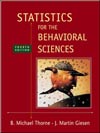| sampling distribution of means | distribution whose scores are means drawn from some population
|
 |
 |
 |
| parent population | the population from which the sample is drawn
|
 |
 |
 |
| central limit theorem | in simplified form, the idea that as sample size increases, the resulting sampling distribution of means more closely approximates the normal distribution
|
 |
 |
 |
| standard error of the mean | standard deviation of the sampling distribution of means
|
 |
 |
 |
| degrees of freedom | number of values free to vary after certain restrictions are placed on the data
|
 |
 |
 |
| estimated standard error of the mean | estimated standard deviation of the sampling distribution of means
|
 |
 |
 |
| t distribution | probability distribution of t scores, which are estimated z scores
|
 |
 |
 |
| confidence interval | range of values within which malmost certainly lies
|
 |
 |
 |
| critical values of t | values of t cutting off deviant portions of the t distribution
|
 |
 |
 |
| interval estimate | estimating a range of values rather than a specific value for a population parameter; the confidence interval is an example of an interval estimate
|
 |
 |
 |
| null hypothesis | in hypothesis testing, the hypothesis that assumes a particular value for a population parameter
|
 |
 |
 |
| alternative hypothesis | in hypothesis testing, the hypothesis that the value of a population parameter is a value other than we have assumed it to be in the null hypothesis
|
 |
 |
 |
| nondirectional hypothesis | an alternative to the null hypothesis that states that the population parameter is not equal to the value specified by the null hypothesis
|
 |
 |
 |
| directional hypothesis | alternative hypothesis that states the direction of the difference between a population parameter and the value assumed by the null hypothesis
|
 |
 |
 |
| significant | in statistics, a term indicating rejection of the null hypothesis
|
 |
 |
 |
| alpha level | the probability level at which the null hypothesis is tested
|
 |
 |
 |
| rejection rule | the rule that states the conditions under which the null hypothesis will be rejected or will fail to be rejected
|
 |
 |
 |
| Type I error | rejecting a true null hypothesis
|
 |
 |
 |
| Type II error | failing to reject a false null hypothesis
|
 |
 |
 |
| power | the probability that a test will reject a false null hypothesis
|
 |
 |
 |
| meta-analysis | procedure using the effect size to analyze the research results from large numbers of studies
|
 |
 |
 |
| effect size | the size of the difference between the null hypothesis and the alternative hypothesis in standardized units
|



 2003 McGraw-Hill Higher Education
2003 McGraw-Hill Higher Education